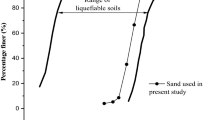Abstract
Soil can liquefy more than once (reliquefaction) when earthquakes occur in succession. A distinctive characteristic of soil reliquefaction behavior is that reliquefaction resistance may be lower than the first liquefaction occurrence, despite an increase in soil density caused by the drainage of groundwater; this characteristic has been proven in some previous laboratory and 1g shaking table tests. The study presented in this paper addresses an attempt to verify whether this decreasing tendency of reliquefaction resistance still exists in centrifuge model tests, which can simulate the gravitational stress of the actual ground under ng conditions. Moreover, the effects of two essential factors including grain size characteristics and the magnitude of the earthquake motion on the reliquefaction behaviors were investigated. The testing results demonstrated that the reliquefaction resistance tends to decrease in terms of the development speed of excess pore water pressure (EPWP), which is because the ground can reliquefy more quickly in the 2nd and subsequent shaking events than in the 1st shaking event. However, the ground settlement caused by the first liquefaction is still larger than that caused by subsequent reliquefaction, which indicates that the ground density still plays a significant role in determining the ground settlement. For the same input motion, the tendency of the EPWP development speed to increase during reliquefaction is more remarkable in medium-coarse sand than that in find sand. For the same sand, different input motions can cause a similar decreasing tendency in reliquefaction resistance for the 2nd shaking event. However, from the 3rd shaking event on, the enhanced effect of reliquefaction resistance due to the increase in ground density is more significant for a smaller input motion.











Similar content being viewed by others
References
Dewoolkar MM, Ko HY, Pak RYS (1999) Centrifuge modelling of models of seismic effects on saturated earth structures. Geotechnique 49(2):247–266
Finn WDL, Bransby PL, Pickering DJ (1970) Effect of strain history on liquefaction of sand. J Soil Mech Found Div 96(6):1917–1934
Ha IS, Olson SM, Seo MW, Kim MM (2011) Evaluation of reliquefaction resistance using shaking table tests. Soil Dyn Earthq Eng 31(4):682–691
Huang Y, Yu M (2013) Review of soil liquefaction characteristics during major earthquakes of the twenty-first century. Nat Hazards 65(3):2375–2384
Huang Y, Zhu C (2016) Safety assessment of antiliquefaction performance of a constructed reservoir embankment. I: experimental assessment. J Perform Constr Facil 31(2):04016101
Ishihara K, Okada S (1978) Effects of stress history on cyclic behavior of sand. Soils Found 18(4):31–45
Ishihara K, Okada S (1982) Effects of large preshearing on cyclic behavior of sand. Soils Found 22(3):109–125
Ko H (1988) Summary of the state-of-the-art in centrifuge model testing. In: Craig WH, James RG, Schofield AN (eds) Centrifuges in soil mechanics. A.A. Balkema, Rotterdam, pp 11–28
Ministry of Construction of China (2009) Code for investigation of geotechnical engineering (GB 50021-2001). State Standard of the People’s Republic of China
Oda M, Kawamoto K, Suzuki K, Fujimori H, Sato M (2001) Microstructural interpretation on reliquefaction of saturated granular soils under cyclic loading. J Geotech Geoenviron 127(5):416–423
Okamura M, Abdoun TH, Dobry R, Sharp MK, Taboada VM (2001) Effects of sand permeability and weak aftershocks on earthquake-induced lateral spreading. Soils Found 41(6):63–77
Tohno I, Shamoto Y (1986) Liquefaction damage to the ground during the 1983 Nihonkai-Chubu (Japan Sea) earthquake in Aomori prefecture, Tohoku, Japan. Nat Disaster Sci 8(1):85–116
Toyota H, Takada S (2016) Variation of liquefaction strength induced by monotonic and cyclic loading histories. J Geotech Geoenviron 143(4):04016120
Wakamatsu K (2012) Recurrence of liquefaction at the same site induced by the 2011 Great East Japan Earthquake compared with previous earthquakes. Paper presented at the 15th world conference on earthquake engineering Lisbon, Portugal
Wang S, Yang J, Onyejekwe S (2013) Effect of previous cyclic shearing on liquefaction resistance of Mississippi River Valley silt. J Mater Civ Eng 25(10):1415–1423
Yamada S, Takamori T, Sato K (2010) Effects on reliquefaction resistance produced by changes in anisotropy during liquefaction. Soils Found 50(1):9–25
Ye B, Ye G, Zhang F, Yashima A (2007) Experiment and numerical simulation of repeated liquefaction–consolidation of sand. Soils Found 47(3):547–558
Acknowledgements
This work was supported by the Program of Shanghai Academic/Technology Research Leader (No. 17XD1403700), the National Natural Science Foundation of China (No. 41472249), the State Key Laboratory of Geohazard Prevention and Geoenvironment Protection (No. SKLGP2016K019), and the Fundamental Research Funds for Central Universities.
Author information
Authors and Affiliations
Corresponding author
Rights and permissions
About this article
Cite this article
Ye, B., Zhang, L., Wang, H. et al. Centrifuge model testing on reliquefaction characteristics of sand. Bull Earthquake Eng 17, 141–157 (2019). https://doi.org/10.1007/s10518-018-0433-6
Received:
Accepted:
Published:
Issue Date:
DOI: https://doi.org/10.1007/s10518-018-0433-6




